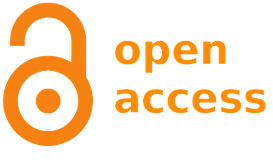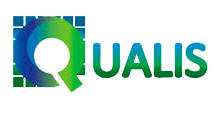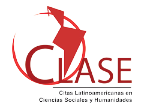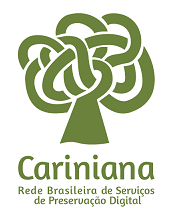Indicadores qualitativos para avaliação do potencial semântico de portais do conhecimento de universidades
DOI:
https://doi.org/10.5433/1981-8920.2022v27n4p487Palavras-chave:
Portais do conhecimento de universidades, Portais semânticos, Indicadores de potencial semântico, Recuperação da informaçãoResumo
Objetivo: Este estudo teve por objetivo propor indicadores qualitativos para a avaliação do potencial semântico de portais do conhecimento de universidades.
Metodologia: A pesquisa incluiu levantamento bibliométrico, análise sistemática e de conteúdo e pesquisa de campo com envio de questionário para coordenadores de TI das 69 universidades federais brasileiras, a fim de identificar as tecnologias e os recursos humanos disponíveis no portal de cada instituição. O tratamento dos dados foi efetuado mediante análise estatística descritiva e os indicadores foram validados por um painel de especialistas.
Resultados: O mapeamento da rede de portais universitários semânticos evidenciou os atores humanos e não humanos e suas inter-relações marcadas por laços fortes e fracos. Foi proposto um conjunto de 18 indicadores qualitativos construídos a partir de preceitos semânticos e sociotécnicos.
Conclusões: O conjunto de indicadores pode ser usado como instrumento de gestão, a fim de disponibilizar pesquisa semântica que facilita o acesso à informação relevante, além de favorecer a interoperabilidade e as ações de comunicação e de colaboração, contribuindo para a evolução dos portais do conhecimento de universidades como uma aplicação sociotécnica.
Downloads
Referências
AMATO, F.; MOSCATO, V.; PICARIELLO, A.; COLACE, F.; DE SANTO, M.; SCHREIBER, F. A.; TANCA, L. Big data meets digital cultural heritage: design and implementation of SCRABS, a smart context-aware browsing assistant for cultural environment. Journal on Computing and Cultural Heritage, New York, v. 10, n. 6, p. 1-23, Apr. 2017. DOI: https://doi.org/10.1145/3012286. Disponível em: https://dl.acm.org/doi/10.1145/3012286. Acesso em: 15 abr. 2021. DOI: https://doi.org/10.1145/3012286
ANDRADE, G. R. B. de; VAITSMAN, J.; FARIAS, L. O. Metodologia de elaboração do índice de responsividade do serviço (IRS). Cadernos de Saúde Pública, Rio de Janeiro, v. 26, n. 3, p. 523-534, mar. 2010. DOI: https://doi.org/10.1590/S0102-311X2010000300010. Disponível em: https://www.scielo.br/j/csp/a/ctcvtSrMjVdJRgqGFvNSvbT/?lang=pt. Acesso em: 15 fev. 2021. DOI: https://doi.org/10.1590/S0102-311X2010000300010
AROUA, E.; MOURAD, A. An ontology-based framework for enhancing personalized content and retrieval information. In: INTERNATIONAL CONFERENCE ON RESEARCH CHALLENGES IN INFORMATION SCIENCE, 11., 2017. Proceedings [...]. Brighton: IEEE, 2017. Disponível em: https://doi.org/10.1109/RCIS.2017.7956547. Acesso em: 15 fev. 2021. DOI: https://doi.org/10.1109/RCIS.2017.7956547
BARDIN, L. Análise de conteúdo. 3. ed. Lisboa: Edições 70, 2011.
BENABDERRAHMANE, S.; MELLOULI, N.; LAMOLLE, M.; PAROUBEK, P. Smart4Job: a big data framework for intelligent job offers broadcasting using time series forecasting and semantic classification. Big data Research, Netherlands, v. 7, p. 16-30, Mar. 2017. DOI: https://doi.org/10.1016/j.bdr.2016.11.001. Disponível em: https://www.sciencedirect.com/science/article/abs/pii/S2214579616300442?via%3Dihub. Acesso em: 10 nov. 2021. DOI: https://doi.org/10.1016/j.bdr.2016.11.001
BERNERS-LEE, T.; HENDLER, J.; LASSILA, O. The semantic Web: a new form of Web content that is meaningful to computers will unleash a revolution of new possibilities. Scientific American, New York, v. 284, n. 5, p. 1-5, Mar. 2001.
BIZER, C.; HEATH, T.; BERNERS-LEE, T. Linked data: the story so far. International Journal on Semantic Web and Information Systems, Hershey, v. 5, n. 2, p. 1-22, 2009. DOI: http://dx.doi.org/10.4018/jswis.2009081901. Acesso em: 17 out. 2021. DOI: https://doi.org/10.4018/jswis.2009081901
BÖRNER, K.; CONLON, M.; CORSON-RIKERT, J.; DING, Y. VIVO: A semantic approach to scholarly networking and discovery. San Rafael: Morgan & Claypool Publishers, 2012. DOI: https://doi.org/10.2200/S00428ED1V01Y201207WBE002. Acesso em: 20 jul. 2021. DOI: https://doi.org/10.1007/978-3-031-79435-3
BURNS, T. R. The sociology of complex systems: an overview of actor-system-dynamics theory. World Futures: the Journal of New Paradigm Research, Milton, v. 62, n. 6, p. 411-440, Nov. 2006. DOI: https://doi.org/10.1080/02604020600798619. Disponível em: https://www.tandfonline.com/doi/full/10.1080/02604020600798619. Acesso em: 22 set. 2021. DOI: https://doi.org/10.1080/02604020600798619
CALLON, M. Society in the making: the study of technology as a tool for sociological analysis. In: BIJKER, W.; HUGHES, T.; PINCH, T. (ed.). The social construction of technological systems: new directions in the sociology and history of technology. Cambridge: MIT Press, 1989. p. 83-103.
CALLON, M. The sociology of an actor-network: the case of the electric vehicle. In: CALLON, M.; LAW, J.; RIP, A. (ed.). Mapping the dynamics of science and technology. Houndmills: Macmillan Press, 1986, p. 19-34. DOI: https://doi.org/10.1007/978-1-349-07408-2_2
CRESPO BORGES, T. Respuestas a 16 preguntas sobre el empleo de expertos encruz la investigación pedagogica. Lima: Editorial San Marcos, 2007.
CRESWELL, J. W.; CLARK, V. L. P. Pesquisa de métodos mistos. 2. ed. Porto Alegre: Penso, 2013.
DONABEDIAN, A. The methods and findings of quality assessment and monitoring: an ilustraded analysis. Ann Arbor: Health Administration Press, 1985. DOI: https://doi.org/10.1097/01445442-198507000-00011
DUARTE, M. M. G.; HARA, C. S. Otimização do Mapeamento de Consultas SPARQL para SQL. In: ESCOLA REGIONAL DE BANCO DE DADOS (ERBD), 14., 2018, Rio Grande. Anais [...]. Porto Alegre: Sociedade Brasileira de Computação, 2018.
EL HAJI, E.; AZMANI, A.; El HARZLI, M. Multi-expert system design for educational and career guidance: an approach based on a multi-agent system and ontology. International Journal of Computer Science Issues, Mauritius, v. 11, n. 5, p. 46-52, Sep. 2014. Disponível em: http://www.ijcsi.org/papers/IJCSI-11-5-2-46-52.pdf. Acesso em: 02 out. 2022.
GIL, A. C. Como elaborar projetos de pesquisa. 5. ed. São Paulo: Atlas, 2010.
GRANOVETTER, M. The strength of weak ties: a network theory revisited. Sociological Theory, [S. l.], v. 1, p. 201-233, 1983. DOI: https://doi.org/10.2307/202051. Disponível em: https://www.jstor.org/stable/202051. Acesso em: 02 out. 2022. DOI: https://doi.org/10.2307/202051
GRUBER, Tom. What is an ontology? [S. l.], 1996. Disponível em: http://www-ksl.stanford.edu/kst/what-is-an-ontology.html. Acesso em: 01 maio 2021.
GUARINO, N. Understanding, building and using ontologies. International Journal of Human and Computer Studies, Londres, v. 45, n. 2-3, p. 293-310, 1997. Disponível em: http://ksi.cpsc.ucalgary.ca/KAW/KAW96/guarino/guarino.html. Acesso em: 10 jan. 2021. DOI: https://doi.org/10.1006/ijhc.1996.0091
GUEDES, J. A. S.; STRAUHS, F. R. Portais do conhecimento de universidades: um quadro referencial para avaliação de potencial semântico. Liinc em Revista, Rio de Janeiro, v. 12, n. 1, p. 166-179, maio 2016. DOI: 10.18617/liinc.v12i1.833. Disponível em: http://revista.ibict.br/liinc/article/view/3667/3114. Acesso em 17 nov. 2021. DOI: https://doi.org/10.18617/liinc.v12i1.833
GUO, K.; Liang, Z.; Tang, Y.; Chi, T. SOR: An optimized semantic ontology retrieval algorithm for heterogeneous multimedia big data, Journal Computational Science Education, Durham, v. 28, p. 455-465, Sep. 2018. DOI: https://doi.org/10.1016/j.jocs.2017.02.005. Disponível em: https://www.sciencedirect.com/science/article/pii/S187775031730176X?via%3Dihub. Acesso em: 17 nov. 2021. DOI: https://doi.org/10.1016/j.jocs.2017.02.005
HUGHES, T. The Evolution of large technological systems. In: BIJKER, W., HUGHES, T.; PINCH, T. (ed.). The social construction of technological systems: new directions in the sociology and history of technology. Cambridge: MIT Press, 1989. p. 51-82.
IYAMU, T.; MGUDLWA, S. Transformation of healthcare big data through the lens of actor network theory. International Journal of Healthcare Management, Londres, v. 11, n. 3, p. 182-192, 2018. DOI: https://doi.org/10.1080/20479700.2017.1397340. Disponível em: https://www.tandfonline.com/doi/abs/10.1080/20479700.2017.1397340?journalCode=yjhm20. Acesso em: 02 out. 2022. DOI: https://doi.org/10.1080/20479700.2017.1397340
KOIVUNEN, M.; MILLER, E. W3C: Semantic Web activity. In: SEMANTIC WEB KICK-OFF SEMINAR IN FINLAND, 2001, Helsinki. Proceedings […]. Finlândia: Helsinki Institute for Information Technology, 2001. p. 27-43. Disponível em: https://www.cs.helsinki.fi/u/eahyvone/stes/semanticweb/kick-off/proceedings.pdf. Acesso em: 02 out. 2022.
LAST, J. M. A dictionary of epidemiology. 2. ed. New York: Oxford University Press, 1998.
LATOUR, Bruno. Ciência em ação: como seguir cientistas e engenheiros sociedade afora. São Paulo: Editora UNESP, 2001.
LAUSEN, H.; DING, Y.; STOLLBERG, M.; FENSEL, D.; HERNÁNDEZ, R. L.; HAN, S.-K. Semantic Web portals: state-of-the-art survey. Journal of Knowledge Management, West Yorkhire, v. 9, n. 5, p. 40-49, 2005. DOI: https://doi.org/10.1108/13673270510622447. Disponível em: https://www.emerald.com/insight/content/doi/10.1108/13673270510622447/full/html. Acesso em: 17 nov. 2021. DOI: https://doi.org/10.1108/13673270510622447
LAW, J. Notes on the theory of the actor network: ordering, strategy and heterogeneity. Systems Practice, [S. l.] v. 5, p. 379-393, ago. 1992. DOI: https://doi.org/10.1007/BF01059830. Disponível em: https://link.springer.com/article/10.1007/BF01059830#citeas. Acesso em: 02 out. 2022. DOI: https://doi.org/10.1007/BF01059830
LAWAN, A.; RAKIB, A. The semantic Web rule language expressiveness extensions-A survey. ArXiv.org, Ithaca, v. 1, p. 1-39, mar. 2019. DOI: https://doi.org/10.48550/arXiv.1903.11723. Disponível em: https://arxiv.org/abs/1903.11723. Acesso em: 02 out. 2022.
LI, H.; XU, Z.; LI, T.; SUN, G.; CHOO, K.-K. R. An optimized approach for massive web page classification using entity similarity based on semantic network. Future Generation Computer Systems, Amsterdam, v. 76, p. 510-518, Nov. 2017. DOI: https://doi.org/10.1016/j.future.2017.03.003. Disponível em: https://www.sciencedirect.com/science/article/pii/S0167739X17303321?via%3Dihub. Acesso em: 17 nov. 2021. DOI: https://doi.org/10.1016/j.future.2017.03.003
MAATOUK, Y. Building AIPedia ontology to evaluate research impact in artificial intelligence area. Academia Letters, [S. l.], Aug. 2021. DOI: https://doi.org/10.20935/AL2781. Disponível em: https://www.academia.edu/50823108/Building_AIPedia_Ontology_to_Evaluate_Research_Impact_in_Artificial_Intelligence_Area. Acesso em: 20 set. 2021. DOI: https://doi.org/10.20935/AL2781
MAEDCHE, A.; STAAB, S.; STOJANOVIC, N.; STUDER, R.; SURE, Y. SEAL - a framework for developing semantic portals. In: CONFERENCE: ADVANCES IN DATABASES, 18TH BRITISH NATIONAL CONFERENCE ON DATABASES, BNCOD, 18, 2021. Proceedings […]. Chilton, UK, July 9-11, 2001.Disponível em: https://www.researchgate.net/publication/220862674_SEAL_-- a_framework_for_developing_SEmantic_web_portALs. Acesso em 11 set. 2023.
MALHOTRA, N. K. Pesquisa de marketing: uma orientação aplicada. 7. ed. Porto Alegre: Bookman, 2019.
MALHOTRA, M.; NAIR, T. R. G. Evolution of knowledge representation and retrieval techniques. International Journal of Intelligent Systems and Applications, Hong Kong, v. 7, n. 7, p. 18-28, Jun. 2015. DOI: 10.5815/ijisa.2015.07.0. Disponível em: https://www.mecs-press.org/ijisa/ijisa-v7-n7/IJISA-V7-N7-3.pdf. Acesso em: 02 out. 2022. DOI: https://doi.org/10.5815/ijisa.2015.07.03
MARCONI, M. A.; LAKATOS, E. M. Técnicas de pesquisa. 7. ed. São Paulo: Atlas, 2010.
MASNER, J.; Å IMEK, P., KÁNSKÁ, E.; VANÄšK, J. Creation, storage and presentation of information content - semantics, sharing, presentation, and archiving. Agris On-line Papers in Economics and Informatics, Czechia, v.11, n. 1, p. 75-82, mar. 2019. DOI: 10.7160/aol.2019.110108. Disponível em: https://online.agris.cz/archive/2019/01/08. Acesso em: 02 out. 2022. DOI: https://doi.org/10.7160/aol.2019.110108
NGO, V. M.; CAO, T. H. Ontology-based query expansion with latently related named entities for semantic text search. ArXiv.org, Ithaca, v. 1, p. 1-12, jul. 2018. DOI: https://doi.org/10.48550/arXiv.1807.05579. Disponível em: https://arxiv.org/abs/1807.05579. Acesso em: 02 out. 2022.
NGUYEN, P. T.; DI ROCCO, J.; RUBEI, R.; DI RUSCIO, D. An automated approach to assess the similarity of GitHub repositories. Software Quality Journal, Andover, v. 28, p. 595-631, Feb. 2020. DOI: 10.1007/s11219-019-09483-0. Disponível em: https://link.springer.com/article/10.1007/s11219-019-09483-0. Acesso em: 02 out. 2022. DOI: https://doi.org/10.1007/s11219-019-09483-0
NIELSEN, J. Projetando Web sites. Rio de Janeiro: Editora Campus. 2000.
NIELSEN, J.; LORANGER, H. Usabilidade na Web: projetando websites com qualidade. Rio de Janeiro: Elsevier, 2007.
NOY, Natalia F. y McGUINNESS, Deborah L. Desarrollo de Ontologías-101: Guía para crear tu primera ontología. Standford University: Standford, 2005. 29 p. Disponível em : https://citeseer.ist.psu.edu/viewdoc/download;jsessionid=03A40D10E8ACD3D8512411B7E0392CE6?doi=10.1.1.136.5085&rep=rep1&type=pdf. Acesso em 11 set. 2023.
OPEN KNOWLEDGE INTERNACIONAL. How to open data. Disponível em https://okfn.org/opendata/how-to-open-data/. Acesso em: 23 jan. 2022.
REYNOLDS, D; SHABAJEE, P.; CAYZER, S. Semantic Information Portals. In: INTERNATIONAL WORLD WIDE WEB CONFERENCE ON ALTERNATE TRACK PAPERS & POSTERS - WWW Alt., 13., 2004, Nova Iorque. Anais […]. Nova Iorque: ACM, maio 2004. p. 290-291. Disponível em: https://dl.acm.org/doi/abs/10.1145/1013367.1013440. Acesso em: 23 jan. 2022. DOI: https://doi.org/10.1145/1013367.1013440
SAMPIERI, R. H.; COLLADO, C. F.; LUCIO, M. P. B. Metodologia de Pesquisa. 5. ed. Mexico: McGraw-Hill, 2010.
SHIM, Y.; SHIN, D. Analyzing china's fintech industry from the perspective of actor-network theory". Telecommunications Policy, Londres, v. 40, n. 2-3, p. 168-181, 2016. DOI: https://doi.org/10.1016/j.telpol.2015.11.005. Disponível em: https://www.sciencedirect.com/science/article/abs/pii/S0308596115001810. Acesso em: 02 out. 2022. DOI: https://doi.org/10.1016/j.telpol.2015.11.005
SILVA, R.; SANTOS, P., FERNEDA, E. Modelos de recuperação de informação e Web Semântica: a questão da relevância. Informação & Informação, Londrina, v. 18, n. 3, p. 27-44, set./dez. 2013. DOI: https://doi.org/10.5433/1981-8920.2013v18n3p27. Disponível em: https://www.uel.br/revistas/uel/index.php/informacao/article/view/12822. Acesso em: 29 out. 2021. DOI: https://doi.org/10.5433/1981-8920.2013v18n3p27
STANESCU, N. G. A smart approach for e-learning domain: the use of business models and semantic technologies. Informatica Economica, Bucareste, v. 22, n. 2, p. 68-80, 2018. DOI:10.12948/issn14531305/22.2.2018.07. Disponível em: https://www.proquest.com/docview/2067316838/fulltext/A778C2CF1C154A46PQ/1?accountid=146694. Acesso em: 29 out. 2021. DOI: https://doi.org/10.12948/issn14531305/22.2.2018.07
TRIOLA, M. F. Introdução à estatística. 12. ed. Rio de Janeiro: LTC, 2017.
W3C. Standards. Disponível em: http://www.w3.org/standards/. Acesso em: 13 mar. 2022.
WALSHAM, Geoff. Actor-network theory and IS research: current status and future prospects. In: LEE, A.; LIEBENAU, J.; DEGROSS, J. (ed.) Information systems and qualitative research. Boston, MA: IFIP - The International Federation for Information Processing, 1997. DOI:10.1007/978-0-387-35309-8_23. Disponível em: https://link.springer.com/chapter/10.1007/978-0-387-35309-8_23. Acesso em: 11 set. 2023.
WIMMER, H.; YOON, V.; RADA, R. Integrating Knowledge sources: an ontological approach. International Journal of Knowledge Management, Hershey, v. 9, n. 1, p. 60-75, Jan. 2013. DOI: 10.4018/jkm.2013010104. Disponível em: https://www.igi-global.com/gateway/article/77327. Acesso em: 02 out. 2022. DOI: https://doi.org/10.4018/jkm.2013010104
Downloads
Publicado
Como Citar
Edição
Seção
Licença
Copyright (c) 2023 Informação & Informação

Este trabalho está licenciado sob uma licença Creative Commons Attribution 4.0 International License.
A revista se reserva o direito de efetuar, nos originais, alterações de ordem normativa, ortográfica e gramatical, com vistas a manter o padrão culto da língua e a credibilidade do veículo. Respeitará, no entanto, o estilo de escrever dos autores. Alterações, correções ou sugestões de ordem conceitual serão encaminhadas aos autores, quando necessário.
O conteúdo dos textos e a citação e uso de imagens submetidas são de inteira responsabilidade dos autores.
Em todas as citações posteriores, deverá ser consignada a fonte original de publicação, no caso a Informação & Informação.














